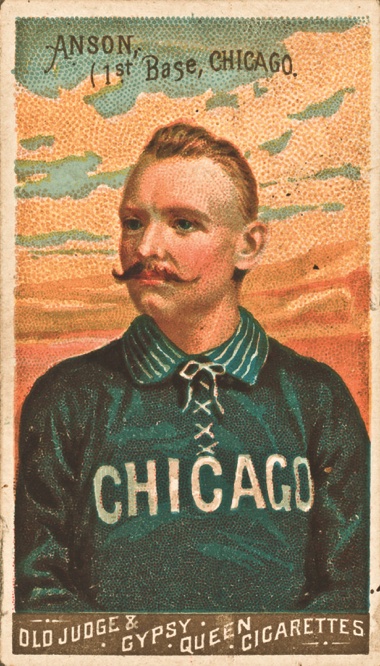Hey Cub fans, “next year” is almost here. After last year, is this the “next year” to end all the previous “next years?” Or is this NEXT YEAR, meaning…THE YEAR?
Well, forget all this “high expectations” stuff. I’d like to go back about 140 years, to a time when the most dominant and influential player in baseball was a Cub.

Some historians call him the game’s first great superstar. He once hit five home runs in two consecutive days, was the first player to amass 3,000 hits in a career, and was elected to the Baseball Hall of Fame in 1939, 17 years after his death.
Can you name him? Adrian Constantine Anson, or Cap Anson.
The Cubs have produced their fair share of stars down through the years – Mordecai Brown, Frank Chance, Johnny Evers, Joe Tinker, Gabby Hartnett, Ferguson Jenkins, Ron Santo, Andre Dawson, Ryne Sandberg, Greg Maddux, Billy Wiliams, Phil Cavarretta, Claude Passeau, Ernie Banks, Hank Sauer, Hack Wilson, Sammy Sosa, Mark Pryor, Kerry Wood…(my apologies to so many others I don’t have space to name).
But Cap Anson was definitely the first great Cub. In the 19th century, when the game was trying to figure out how to organize itself, he made the Cubs one of the dominant teams.
Born in 1852, Anson broke into professional baseball in 1871, at the age of 19. He established himself quickly, because he was physically big, loud, outspoken, and argumentative. He was also talented and innovative. He played his first season for the Rockford Forest Citys, was traded to the Philadelphia Athletics for three seasons (1872-1875), and then spent 22 seasons as a player-manager and first baseman with the Chicago Cubs franchise, which was known then as the Chicago White Stockings and later the Colts. The “Cubs” name showed up when the National league was formally organized around 1900.
He compiled one of the most impressive on-field resumes of the 19th century. He was one of the top five hitters in the National Association (NA, which later became the National League) in batting average, one-base percentage, and on-base plus slugging. In a dead-ball era, he compiled a .334 lifetime batting average, stroked more than 3,400 hits in a 27-season career, clubbed 97 home runs, and drove in 2,075 runs. He was a two-time NL batting champion and won eight RBI titles from 1880 to 1891.
His first two names belied his personality and his role with the White Stockings. After owner William Hulbert named him player-manager, newspapers and fans started calling him “Cap” or “Capt.”
Under Anson’s leadership, the White Stockings won five NA pennants from 1880 to 1886. Anson was among the first managers to employ third-base coaches, use hand signals effectively, have one fielder back up another, signal batters, and establish pitching rotations. He also is credited with developing the hit-and-run play, which his teams employed frequently.
He shares credit with Albert Spalding in the development of spring training activities in warmer climates before the seasons began. His playing days ended in 1897.
He started several sports-related business ventures, most of which didn’t last very long. One of his most successful business ventures after baseball was a combination billiards hall and bowling alley in downtown Chicago. It lasted 10 years, during which time he was named vice-president of the American Bowling Congress and led a team to the five-man national ABC bowling championship in 1904.
Anson is perhaps best known, however, for his racial intolerance and bigotry. While the “black color line” was a product of its time in society and institutional in nature, Anson was one of the most aggressive leaders that enforced it in baseball. He played a major role in preventing blacks from playing in the top leagues of his time.
“He was a major figure in establishing the racial segregation in professional baseball that persisted until the late 1940s,” Wikipedia says in its biography of Anson. “He rightfully should endure as the big leaguer who, until the late 1940s, was involved in the greatest number of reported negative incidents, on the field, relating to blacks.”
He refused to take the field when the opposing roster included black players, and he was instrumental in keeping Bud Fowler and Moses Walker, two of the best black players of the era, from playing at the game’s highest levels.
In his later life, Anson tried all sorts of things. He was elected to serve one year as city clerk in Chicago, and spent much of his later life acting and performing in vaudeville and the theater. He married Virginia Fiegal of Philadelphia in 1876 and became the father of seven children.
He died in Chicago on April 14, 1922, just a few days short of his 70th birthday. He is buried in Oak Woods Cemetery in Chicago.
Cap Anson, the Cubs first and greatest “winner.” Could his legacy rub off on the 2016 Cubs “THIS YEAR?”




